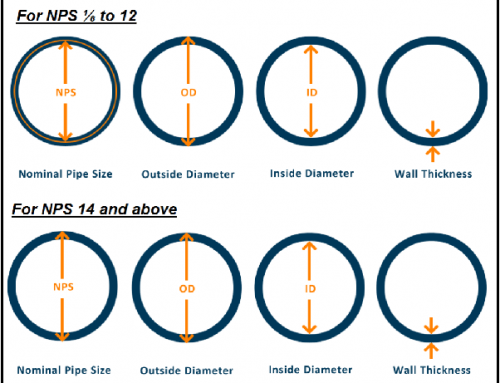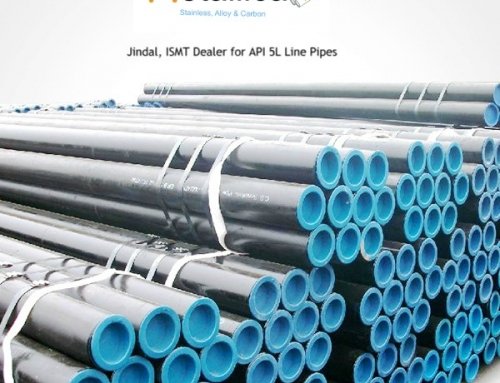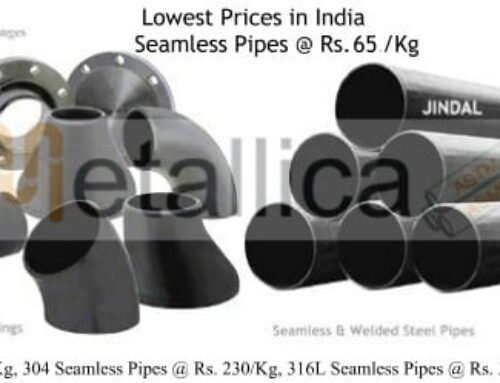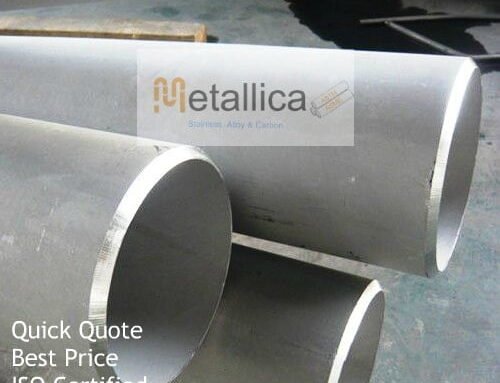Carbon steel is steel with carbon content up to 2.1% by weight. The definition of carbon steel from the American Iron and Steel Institute (AISI) states: Steel is considered to be carbon steel when: no minimum content is specified or required for chromium, cobalt, molybdenum, nickel, niobium, titanium, tungsten, vanadium or zirconium, or any other element to be added to obtain a desired alloying effect; the specified minimum for copper does not exceed 0.40 percent; or the maximum content specified for any of the following elements does not exceed the percentages noted: manganese 1.65, silicon 0.60, copper 0.60. The term “carbon steel” may also be used in reference to steel which is not stainless steel; in this use carbon steel may include alloy steels.
As the carbon percentage content rises, steel has the ability to become harder and stronger through heat treating; however, it becomes less ductile. Regardless of the heat treatment, a higher carbon content reduces weldability. In carbon steels, the higher carbon content lowers the melting point.
Difference Between Carbon Steel and Stainless Steel
Carbon steel and stainless steel have the same basic ingredients of iron and carbon. Their main difference is alloy content—carbon steel has under 10.5 percent alloy content, while stainless steel must contain 10.5 percent chromium or more. That essential difference is what gives carbon steel and stainless steel their distinct physical characteristics.
| Carbon Steel | Stainless Steel |
| Vulnerable to rust | Resistant to rust |
| Brittle | Less Brittle |
| Wear-resistant | Less wear-resistant |
Types of Carbon Steel
Carbon Steel Pipe can be classified into four categories:
- Low carbon steel – Carbon content 0.55-1.05%
- Medium carbon steel- Carbon content 0.25-10.6%
- High carbon steel- Carbon content 0.9-2.5%
- Super High carbon steel- Carbon content 2.5-3.0%
Commonly used Carbon Steel explained below:
- Low Carbon Steel
- Plain carbon steels – very low content of alloying elements and small amounts of Mn.
- Most abundant grade of steel is low carbon steel – greatest quantity produced; least expensive.
- Not responsive to heat treatment; cold working needed to improve the strength.
- Good Weldability and machinability.
- High Strength, Low Alloy (HSLA) steels – alloying elements (like Cu, V, Ni and Mo) up to 10 wt %; have higher strengths and may be heat treated.
- Medium Carbon Steel
- Carbon content in the range of 0.3 – 0.6%.
- Can be heat treated – austenitizing, quenching and then tempering.
- Most often used in tempered condition – tempered martensite.
- Medium carbon steels have low hardenability.
- Addition of Cr, Ni, Mo improves the heat treating capacity.
- Heat treated alloys are stronger but have lower ductility.
- Typical applications – Railway wheels and tracks, gears, crankshafts.
- High Carbon Steel
- High carbon steels – Carbon content 0.6 – 1.4%.
- High C content provides high hardness and strength.
- Hardest and least ductile.
- Used in hardened and tempered condition.
- Strong carbide formers like Cr, V, W are added as alloying elements to from carbides of these metals.
- Used as tool and die steels owing to the high hardness and wear resistance property.
- Super High Carbon Steel
- Approximately 1.25–2.0% carbon content.
- Steels that can be tempered to great hardness.
- Used for special purposes like (non-industrial-purpose) knives, axles or punches.
- Most steels with more than 2.5% carbon content are made using powder metallurgy.
Applications of Carbon Steel
Carbon steel is used in boilers, pressure vessels, heat exchangers, piping, and other moderate-temperature service systems in which good strength and ductility are desired. Significant other factors include cost, availability, and the ease of fabrication.
Effects of Alloying Elements on Steel
- Manganese – strength and hardness; decreases ductility and weldability; effects hardenability of steel.
•Phosphorus – increases strength and hardness and decreases ductility and notch impact toughness of steel.
•Sulfur decreases ductility and notch impact toughness Weldability decreases. Found in the form of sulfide inclusions.
•Silicon – one of the principal deoxidizers used in steel making. In low-carbon steels, silicon is generally detrimental to surface quality.
•Copper – detrimental to hot-working steels; beneficial to corrosion resistance (Cu>0.20%).
•Nickel – ferrite strengthener; increases the hardenability and impact strength of steels.
•Molybdenum – increases the hardenability; enhances the creep resistance of low-alloy steels.
Standard and Code Specification of Carbon Steel
Frequently Used ASTM Grades of Carbon Steel
| Carbon Steel | Type | Standard | Grades | Specification |
| Medium-Temp | Pipes | A106 | A, B, C | This specification covers carbon steel pipe for high-temperature service. |
| Fittings | A234 | WPA, WPB, WPC | This specification covers wrought carbon steel and alloy steel fittings of seamless and welded construction. | |
| Flanges | A105 | This specification covers standards for forged carbon steel piping components, that is, flanges, fittings, Valves, and similar parts, for use in pressure systems at ambient and higher-temperature service conditions. | ||
| Valves | A216 | WCB | This specification covers carbon steel castings for Valves, flanges, fittings, or other pressure-containing parts for high-temperature service and of quality suitable for assembly with other castings or wrought-steel parts by fusion welding. | |
| Bolts & Nuts | A193 | B7 | This specification covers alloy and stainless steel bolting material for pressure vessels, Valves, flanges, and fittings for high temperature or high pressure service, or other special purpose applications. | |
| A194 | 2H | Standard specification for nuts in many different material types. | ||
| High-Temp | Pipes | A335 | P1, P11, P12, P22, P5, P9 | This specification covers seamless ferritic alloy-steel pipe for high-temperature service. |
| Fittings | A234 | WP1, WP11, WP12, WP22, WP5, WP9 | This specification covers wrought carbon steel and alloy steel fittings of seamless and welded construction. | |
| Flanges | A182 | F1, F11, F12, F22, F5, F9 | This specification covers forged or rolled alloy and stainless steel pipe flanges, forged fittings, and Valves and parts for high-temperature service. | |
| Valves | A217 | WC1, WC6, WC9, C5, C12 | This specification covers steel castings, martensitic stainless steel and alloys steel castings for Valves, flanges, fittings, and other pressure-containing parts intended primarily for high-temperature and corrosive service. | |
| Bolts & Nuts | A193 | B7 | This specification covers alloy and stainless steel bolting material for pressure vessels, Valves, flanges, and fittings for high temperature or high pressure service, or other special purpose applications. | |
| A194 | 2H | Standard specification for nuts in many different material types. | ||
| Low-Temp | Pipes | A333 | 6, 3 | This specification covers wall seamless and welded carbon and alloy steel pipe intended for use at low temperatures. |
| Fittings | A420 | WPL6, WPL3 | Standard specification for piping fittings of wrought carbon steel and alloy steel for low-temperature service. | |
| Flanges | A182 | F304, F316, F321, F347 | This specification covers forged or rolled alloy and stainless steel pipe flanges, forged fittings, and Valves and parts for high-temperature service. | |
| Valves | A182 | F304, F316, F321, F347 | This specification covers forged or rolled alloy and stainless steel pipe flanges, forged fittings, and Valves and parts for high-temperature service. | |
| Bolts & Nuts | A193 | B8 | This specification covers alloy and stainless steel bolting material for pressure vessels, Valves, flanges, and fittings for high temperature or high pressure service, or other special purpose applications. | |
| A194 | 8 | Standard specification for nuts in many different material types. |
Heat Treatment
The purpose of heat treating carbon steel is to change the mechanical properties of steel, usually ductility, hardness, yield strength, or impact resistance. Note that the electrical and thermal conductivity are only slightly altered. As with most strengthening techniques for steel, Young’s modulus (elasticity) is unaffected. All treatments of steel, trade ductility for increased strength and vice versa. Iron has a higher solubility for carbon in the austenite phase; therefore all heat treatments, except spheroidizing and process annealing, start by heating the steel to a temperature at which the austenitic phase can exist. The steel is then quenched (heat drawn out) at a moderate to low rate allowing carbon to diffuse out of the austenite forming iron-carbide (cementite) and leaving ferrite, or at a high rate, trapping the carbon within the iron thus forming martensite. The rate at which the steel is cooled through the eutectoid temperature (about 727°C) affects the rate at which carbon diffuses out of austenite and forms cementite. Generally speaking, cooling swiftly will leave iron carbide finely dispersed and produce a fine grained pearlite and cooling slowly will give a coarser pearlite. Cooling a hypoeutectoid steel (less than 0.77 wt% C) results in a lamellar-pearlitic structure of iron carbide layers with α-ferrite (nearly pure iron) in between. If it is hypereutectoid steel (more than 0.77 wt% C) then the structure is full pearlite with small grains (larger than the pearlite lamella) of cementite formed on the grain boundaries. A eutectoid steel (0.77% carbon) will have a pearlite structure throughout the grains with no cementite at the boundaries. The relative amounts of constituents are found using the lever rule. The following is a list of the types of heat treatments possible:
- Spheroidizing
- Full annealing
- Process annealing
- Isothermal annealing
- Normalizing
- Quenching
- Martempering (Marquenching)
- Tempering
- Austempering
Forging Temperature of Steel
| Steel Type | Maximum forging temperature (°F / °C) | Burning temperature (°F / °C) |
| 1.5% carbon | 1920 / 1049 | 2080 / 1140 |
| 1.1% carbon | 1980 / 1082 | 2140 / 1171 |
| 0.9% carbon | 2050 / 1121 | 2230 / 1221 |
| 0.5% carbon | 2280 / 1249 | 2460 / 1349 |
| 0.2% carbon | 2410 / 1321 | 2680 / 1471 |
| 3.0% nickel steel | 2280 / 1249 | 2500 / 1371 |
| 3.0% nickel–chromium steel | 2280 / 1249 | 2500 / 1371 |
| 5.0% nickel (case-hardening) steel | 2320 / 1271 | 2640 / 1449 |
| Chromium–vanadium steel | 2280 / 1249 | 2460 / 1349 |
| High-speed steel | 2370 / 1299 | 2520 / 1385 |
| Stainless steel | 2340 / 1282 | 2520 / 1385 |
| Austenitic chromium–nickel steel | 2370 / 1299 | 2590 / 1420 |
| Silico-manganese spring steel | 2280 / 1249 | 2460 / 1350 |
[Source: From Web]







Leave A Comment